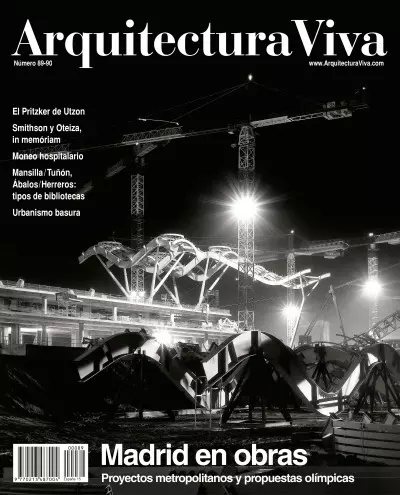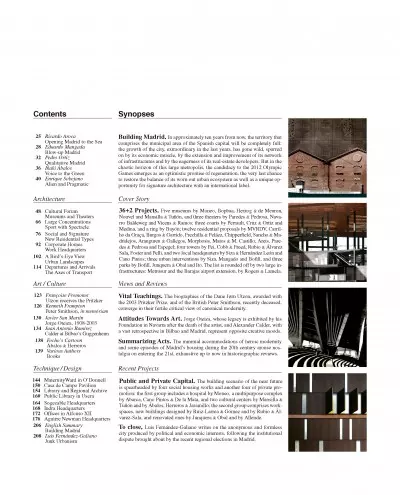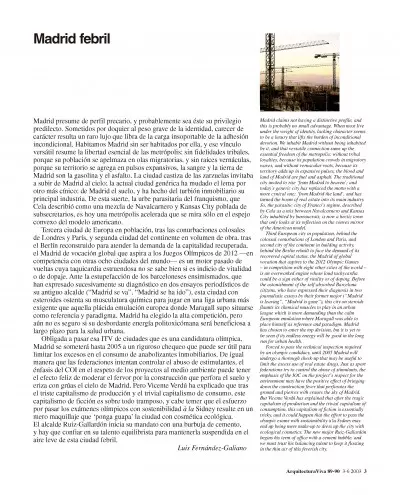Synopses
Building Madrid. In approximately ten years from now, the territory that comprises the municipal area of the Spanish capital will be completely full: the growth of the city, extraordinary in the last years, has gone wild, spurred on by its economic muscle, by the extension and improvement of its network of infrastructures and by the eagerness of its real-estate developers. But in the chaotic horizon of this large metropolis, the candidacy to the 2012 Olympic Games emerges as an optimistic promise of regeneration, the very last chance to restore the balance of its worn out urban ecosystem as well as a unique opportunity for signature architecture with an international label.
Contents
RicardoAroca
Opening Madrid to the Sea
Eduardo Mangada
Blow-up Madrid
Pedro Ortiz
Qualitative Madrid
Iñaki Ábalos
Voice to the Green
Enrique Sobejano
Alien and Pragmatic
Cover Story
36+2 Projects. Five museums by Moneo, Bopbaa, Herzog & de Meuron, Nouvel and Mansilla & Tuñón, and three theaters by Paredes & Pedrosa, Navarro Baldeweg and Vicens & Ramos; three courts by Perrault, Cruz & Ortiz and Medina, and a ring by Bayón; twelve residential proposals by MVRDV, Carrilho da Graça, Burgos & Garrido, Frechilla & Peláez, Chipperfield, Sancho & Madridejos, Aranguren & Gallegos, Morphosis, Matos & M. Castillo, Arets, Paredes & Pedrosa and Espegel; four towers by Pei, Cobb & Freed, Rubio & Álvarez Sala, Foster and Pelli, and two local headquarters by Siza & Hernández León and Cano Pintos; three urban interventions by Siza, Mangado and Bofill, and three parks by Bofill, Junquera & Obal and Ito. The list is rounded off by two large infrastructures: Metrosur and the Barajas airport extension, by Rogers & Lamela.
Architecture
Cultural Forum. Museums and Theaters
Large Concentrations. Sport with Spectacle
Social and Signature. New Residential Types
Corporate Homes. Work Headquarters
A Bird’s-Eye View. Urban Landscapes
Departures and Arrivals. The Axes of Transport
Views and Reviews
Vital Teachings. The biographies of the Dane Jørn Utzon, awarded with the 2003 Pritzker Prize, and of the British Peter Smithson, recently deceased, converge in their fertile critical view of canonical modernity
Art / Culture
Françoise Fromonot
Utzon receives the Pritzker
Kenneth Frampton
Peter Smithson, in memóriam
Attitudes Towards Art. Jorge Oteiza, whose legacy is exhibited by his Foundation in Navarra after the death of the artist, and Alexander Calder, with a vast retrospective in Bilbao and Madrid, represent opposite creative moods. Javier San Martín
Jorge Oteiza, 1908-2003
Juan Antonio Ramírez
Calder at Bilbao’s GuggenheimSummarizing Acts. The minimal accommodations of heroic modernity and some episodes of Madrid’s housing during the 20th century arouse nostalgia on entering the 21st, exhaustive up to now in historiographic reviews.
Focho’s Cartoon
Ábalos & Herreros
Various Authors
Books
Recent projects
Public and Private Capital. The building scenario of the near future is spearheaded by four social housing works and another four of private promotion: the first group includes a hospital by Moneo, a multipurpose complex by Abarca, Cano Pintos & De la Mata, and two cultural centers by Mansilla & Tuñón and by Ábalos, Herreros & Jaramillo; the second group comprises workspaces, new buildings designed by Ruiz-Larrea & Gómez and by Rubio & Álvarez-Sala, and renovated ones by Junquera & Obal and by Allende.
Technique / Design
MaternityWard in O’Donnell
Casa de Campo Pavilion
Library and Regional Archive
Public Library in Usera
Sogecable Headquarters
Indra Headquarters
Offices in Alfonso XII
Aguirre Newman Headquarters
To close, Luis Fernández-Galiano writes on the anonymous and formless city produced by political and economic interests, following the institutional dispute brought about by the recent regional elections in Madrid. English Summary
Building Madrid
Luis Fernández-Galiano
Junk Urbanism
Luis Fernández-Galiano
Building Madrid
Madrid claims not having a distinctive profile, and this is probably no small advantage. When most live under the weight of identity, lacking character seems to be a luxury that lifts the burden of inconditional devotion. We inhabit Madrid without being inhabited by it, and that versatile connection sums up the essential freedom of the metropolis: without tribal loyalties, because its population crowds in migratory waves, and without vernacular roots, because its territory adds up in expansive pulses, the blood and land of Madrid are fuel and asphalt. The traditional city invited to rise ‘from Madrid to heaven’; and today’s generic city has replaced the motto with a more cynical one: ‘from Madrid the land’, and has turned the boom of real estate into its main industry. So, the parasitic city of Franco’s regime, described by Cela as a mix between Navalcarnero and Kansas City inhabited by bureaucrats, is now a hectic town that only looks at its reflection on the convex mirror of the American model.
Third European city in population, behind the colossal conurbations of London and Paris, and second city of the continent in building activity, behind the Berlin rebuilt to face the demand of its recovered capital status, the Madrid of global vocation that aspires to the 2012 Olympic Games – in competition with eight other cities of the world – is an overworked engine whose loud tachycardia could be a sign either of vitality or of doping. Before the astonishment of the self-absorbed Barcelona citizens, who have expressed their diagnosis in two journalistic essays by their former major (“Madrid is leaving”, “Madrid is gone”), this city on steroids flaunts its chemical muscles to play in an urban league which is more demanding than the calm European emulation where Maragall was able to place himself as reference and paradigm. Madrid has chosen to enter the top division, but it is yet to be seen if its endless energy will be good in the long run for urban health.
Forced to pass the technical inspection required by an olympic candidacy, until 2005 Madrid will undergo a thorough check-up that may be useful to limit the excess use of real estate drugs. Just as sport federations try to control the abuse of stimulants, the emphasis of the IOC on the project’s respect for the environment may have the positive effect of bringing down the construction fever that perforates the ground and pierces with cranes the sky of Madrid. But Vicente Verdú has explained that after the tragic capitalism of production and the trivial capitalism of consumption, this capitalism of fiction is essentially tricky, and it could happen that the effort to pass the olympic exams with sustainability à la Sydney may end up being mere make-up to dress up the city with ecological cosmetics. The new major Ruiz-Gallardón begins his term of office with a cement bubble, and we must trust his balancing talent to keep it floating in the thin air of this feverish city.








